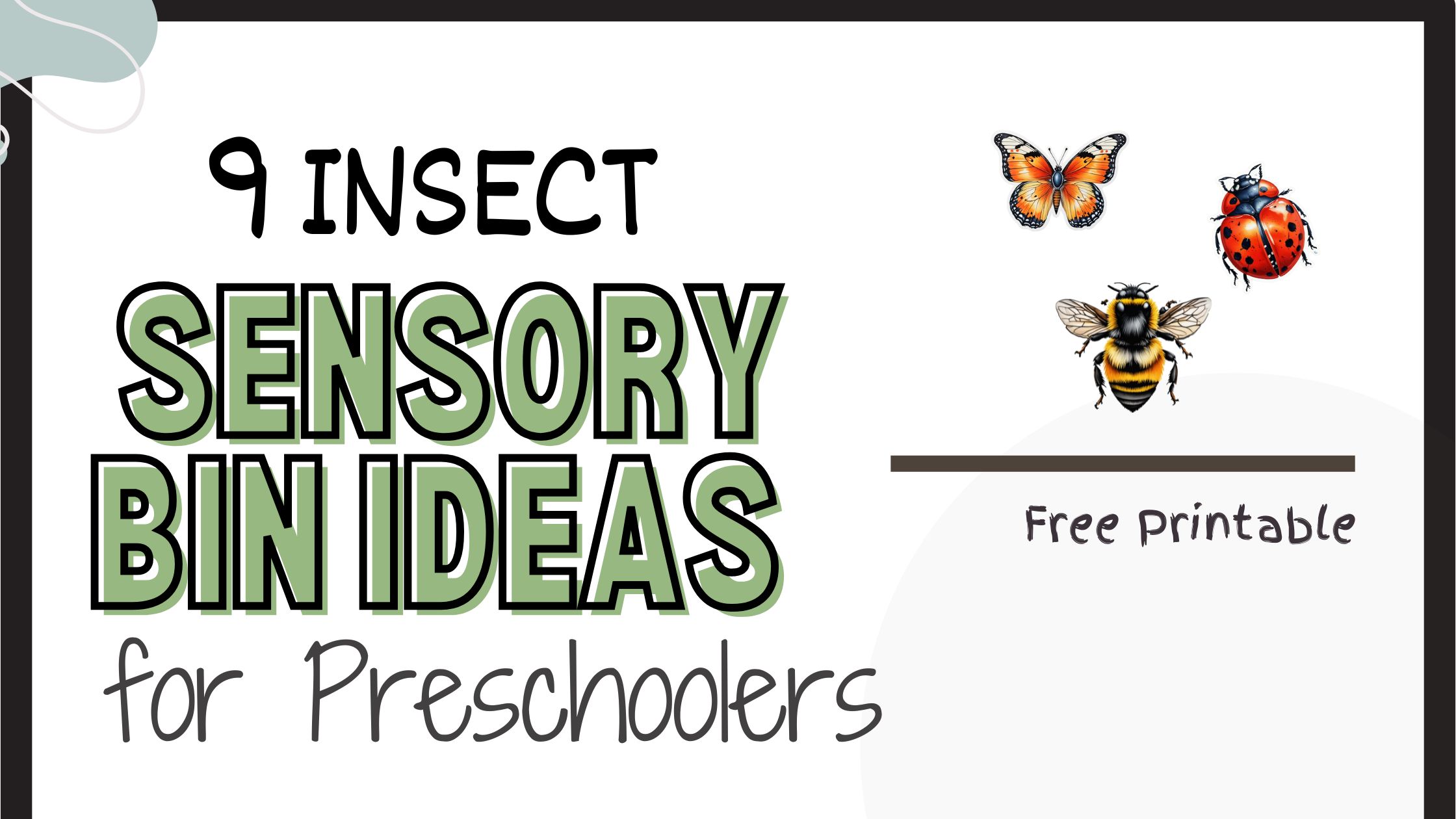Hey there mommas! 🌟 It’s summer and the creepy crawlies are everywhere. I am not the fondest of bugs. Tho I have a soft spot for bees. (They are just so hard working!). I am scared of ladybugs … they bite. Despite my not so fondness I’d like to introduce Luca to insects. (Without touching the real ones… he likes catching spiders…)
Today, I’m super excited to share some amazing bug sensory bin ideas that will keep your little ones engaged, learning, and having a blast. Sensory bins are a fantastic way to develop fine motor skills, encourage imaginative play, and introduce children to the wonderful world of insects. Let’s dive into the creepy, crawly fun! 🐜✨
Why Bug-Themed Sensory Bins? 🐛
Bug-themed sensory bins are perfect for preschoolers and toddlers who are naturally curious about the world around them. These bins combine the excitement of a bug hunt with the benefits of sensory play, creating a hands-on learning experience that’s both educational and entertaining. Plus, they’re a great way to bring the outdoors inside, especially on rainy days!

Bug Sensory Bin Ideas 🦋
1. Ladybug Land 🐞
What You’ll Need:
- Red and black rice or beans (or brown felt)
- Plastic ladybugs
- Leaves and twigs
- Magnifying glass
Instructions: Fill a bin with red and black rice or beans to create a ladybug habitat. Scatter plastic ladybugs throughout the bin, and add leaves and twigs for a natural touch. Provide a magnifying glass so your child can search for and examine the ladybugs up close. This activity enhances fine motor skills and encourages observational skills.
2. Butterfly Garden 🦋
What You’ll Need:
- Flower petals (real or fake)
- Plastic butterflies
- Small watering can
- Green felt or paper
Instructions: Create a butterfly garden by filling the bin with flower petals and green felt or paper to mimic grass. Add plastic butterflies and a small watering can. Let your child water the “flowers” and help the butterflies “fly” from flower to flower. This bin is perfect for imaginative play and exploring the beauty of nature.
3. Ant Hill Adventure 🐜
What You’ll Need:
- Kinetic sand
- Plastic ants
- Small rocks
- Toy shovel
Instructions: Fill the bin with kinetic sand to represent an ant hill. Add plastic ants and small rocks. Provide a toy shovel so your child can dig and create tunnels for the ants. This sensory bin is great for developing fine motor skills and understanding the concept of teamwork as ants work together to build their hill.
4. Spider Web Sensory Bin 🕷️
What You’ll Need:
- White string or yarn
- Plastic spiders
- Moss, leaves, pine tree branches, or beans
- Tweezers
Instructions: Create a spider web using white string or yarn stretched across the bin. Fill the bottom with black beans and scatter plastic spiders throughout. Give your child tweezers to pick up the spiders and place them in the web. This bin is excellent for enhancing fine motor skills and hand-eye coordination.

5. Bumblebee Buzz 🐝
What You’ll Need:
- Plastic bees
- Small flowers
- Spoons
Instructions: Add plastic bees and small flowers. Provide spoons for your child to scoop the bees and place them on the flowers. This activity helps develop fine motor skills and introduces the concept of pollination.
6. Wormy Dirt Bin 🪱
What You’ll Need:
- Chocolate pudding or brown kinetic sand
- Gummy worms
- Plastic shovels and cups
Instructions: Fill the bin with chocolate pudding or brown kinetic sand to mimic dirt. Add gummy worms and provide plastic shovels and cups. Let your child dig for the worms and transfer them into the cups. This sensory bin is a fun and delicious way to explore the concept of soil and worms’ role in it. It’s more for older kids.
7. Dragonfly Pond 🏞️
What You’ll Need:
- Blue water beads
- Plastic dragonflies
- Green felt (for lily pads)
- Small rocks
Instructions: Create a pond with blue water beads and add plastic dragonflies. Cut green felt into lily pad shapes and place them on top of the water beads. Add small rocks around the edges. This bin provides a calming sensory experience and encourages imaginative play.
8. Insect Safari 🌿
What You’ll Need:
- Fake grass or green rice
- Various plastic insects
- Small jars with lids
- Bug tongs
Instructions: Fill the bin with fake grass or green rice to create a jungle environment. Add various plastic insects and provide small jars with lids and bug tongs. Let your child go on a bug hunt, using the tongs to collect insects and place them in the jars. This activity enhances fine motor skills and teaches about different insect species.
9. Caterpillar Crawl 🐛
What You’ll Need:
- Colored pasta (green and brown)
- Plastic caterpillars
- Leaves and small branches
- Plastic containers
Instructions: Fill the bin with colored pasta to create a caterpillar habitat. Add plastic caterpillars, leaves, and small branches. Provide plastic containers for your child to collect the caterpillars and move them around. This bin encourages fine motor skills and imaginative play.
10. Bug-Themed Sensory Bottles 🌟
If you love sensory bins, you’ll definitely want to try out sensory bottles too! They’re perfect for mess-free exploration and can be taken on the go. Check out my post on Sensory Bottle Ideas for some magical inspirations. You can create bug-themed sensory bottles using glitter, plastic insects, and colorful beads. These bottles are great for visual stimulation and fine motor development.
Bug Printable for sensory bin

Benefits of Bug-Themed Sensory Bins 🐞
Bug-themed sensory bins offer numerous benefits, including:
- Enhancing Fine Motor Skills: Using tools like tweezers, shovels, and tongs helps develop hand strength and coordination.
- Encouraging Imaginative Play: Children can create their own stories and scenarios, fostering creativity and cognitive development.
- Promoting Observational Skills: Searching for and examining bugs teaches attention to detail and scientific curiosity.
- Providing Sensory Stimulation: Different textures, colors, and materials engage the senses and promote sensory processing.
Tips for Creating Successful Sensory Bins 🌟
- Supervise at All Times 👀: Always keep an eye on your child during sensory play to ensure their safety.
- Choose Age-Appropriate Materials 🧸: Make sure all items are non-toxic and suitable for your child’s age group.
- Keep It Simple 🧩: You don’t need elaborate setups. Often, the simplest bins are the most effective.
- Rotate Themes Regularly 🔄: Keep things fresh and exciting by rotating themes and materials.
- Involve Your Child in Setup 🛠️: Let your child help set up the sensory bin to increase their engagement and ownership.
Answering Common Questions ❓
1. How do I clean up sensory bins? Cleanup depends on the materials used. Dry items like rice or beans can be swept up and stored for future use. Wet materials like pudding should be disposed of after play. Encourage your child to help with cleanup to make it part of the play process.
2. Are sensory bins messy? They can be, but the benefits far outweigh the mess! Use a large bin or tray to contain materials, and consider placing a mat or sheet underneath the play area to catch spills. Or like me set them up in the babypool (I have one that doesn’t need air) Obviously in summer it’s easier to wash everything down.
3. How often should I change the sensory bin theme? There’s no set rule. Some children enjoy exploring the same theme for weeks, while others may want a new theme every few days. Follow your child’s lead and switch things up when interest wanes.
More Sensory Play and Insect Play Ideas 🔗
If you’re looking for more sensory play ideas, check out these posts:
- Layered Sensory Bottles: Stunning sensory bottles that captivate with layers of colors and textures.
- Sound Sensory Bottles: Explore the world of sound with these DIY sensory bottles.
- Nature Sensory Bottle Ideas: Bring the beauty of nature into your sensory play.
- Sensory Play Crafts for Toddlers: More fun and crafty sensory play ideas for toddlers.
- The Imagination Tree – Bug Activities for Kids
- Fun-A-Day – Exploring Bugs with Kids
Conclusion 🐞🌟
Bug-themed sensory bins are a fantastic way to engage your child in fun, educational play. From exploring different textures and colors to developing fine motor skills and fostering creativity, these bins offer endless opportunities for learning and growth. So, gather your materials, set up a bug-themed sensory bin, and watch your child’s eyes light up with excitement and curiosity. Happy playing!
Pin it for Later

📌 If you loved these bug-themed sensory bins, I’d love to hear about it! Have you tried any of these ideas with your little ones? Did you come up with your own creative twists? Please share your experiences and any new ideas in the comments below. Your feedback and stories are so inspiring!
And don’t forget to share the fun with others! If you found this post helpful, please pin it to your Pinterest boards for other parents to discover. Let’s spread the joy of sensory play far and wide!





Leave a Reply